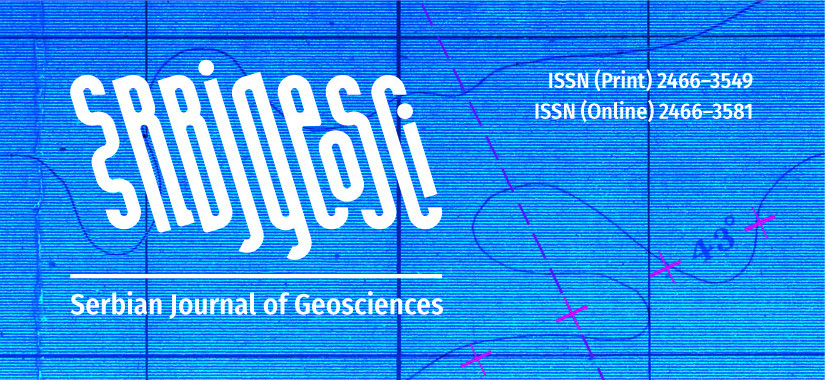Aims and scope
Serbian Journal of Geosciences is a geographical, scientific journal published by the Department of Geography, Faculty of Sciences, University of Niš. The journal is committed to publishing a range of topics in physical, human, and regional geography, cartography, geographical information system, and other related fields of geosciences.
The specific topics may include but are not limited to:
- Geology
- Paleogeography
- Geomorphology
- Pedology
- Geochemistry
- Geophysics
- Hydrology
- Biogeography
- Climatology
- Mathematical Geography
- Demogeography
- Poleogeography
- Economical Geography
- Historical Geography
- Political Geography
- Medical Geography
- Methodology Teaching Geography
- Tourism Geography
- Ecotourism
- Environmental Protection
- Tourism Planning
- Spatial Planning
- Cartography
- Geovisualization
- Remote sensing
- Geographic Information Systems
Types of paper
Original research article: reporting previously unpublished research.
Review article: providing a comprehensive critical evaluation of existing data in specific scientific issues and perspectives for future research.
Short communication: intended for the presentation of original scientific research that requires expedited publication.
Methodology article: reporting a new method or an improved version of the existing one.
Manuscript preparation
Manuscripts should be prepared in English using a word processor at A4 paper size with all margins of 2.5 cm. The preferred font is Times New Roman 11 pt. The text should be double-spaced, with included page numbers and continuous line numbers. The first paragraph after a heading or subheading, need not be indented. Tables and figures should be numbered serially and must be referred to in the manuscript. The manuscript title should be concise and informative. Author names and affiliations (including full postal addresses) should be indicated. The email addresses of all authors should be provided. The corresponding author should be indicated.
Article structure
Abstract: Each article should be preceded by an abstract, highlighting the main objectives, results, and major conclusions of the paper. It should not contain more than 250 words.
Keywords: A maximum of 6 keywords (other than those contained in the title) should be identified.
Introduction: State the main objectives with research background avoiding extensive literature review.
Materials and methods: Provide details on the methodology applied in such a way that it could be reproduced by independent researchers. Previously published methods should be just briefly presented and indicated by a reference. Statistical methods and programs should also be indicated here.
Results: Results should be presented understandably and concisely, followed each other in a coherent sequence.
Discussion: This should explore the work’s observations and the significance of the results obtained without repeating the results. Extensive discussion of published literature should be avoided.
Results and discussion could be combined into a single section.
Conclusions. The main conclusions of the work should be briefly presented in this section. This section may stand alone or as a subsection of a Discussion or Results and Discussion section.
Acknowledgments: The sources of support, including sponsorship institutions and individuals who provided assistance during the research, should be indicated in this section at the end of the article before the references.
References: The list at the end of the manuscript should include only references cited in the text. It should be arranged alphabetically by the surname of the first author and then further chronologically if necessary. If there is more than one reference from the same author(s) in the same year, the letters ’a’, ’b’, ’c’, etc., should be added after the year of publication.
Examples:
Reference to a journal publication:
Marković, S.B., Hambach, U., Catto, N., Jovanović, M., Buggle, B., Machalett, B., Zöller, L., Glaser, B., Frechen, M., 2009. The middle and late Pleistocene loess-paleosol sequences at Batajanica, Vojvodina, Serbia. Quatern. Int., 198, 255-266.
Reference to a book:
Onjia, A., 2016. Chemometric Approach to the Experiment Optimization and Data Evaluation in Analytical Chemistry, University of Belgrade, Faculty of Technology and Metallurgy, Belgrade.
Reference to a chapter in an edited book:
Marjanović, M., Bajat, B., Abolmasov, B., Kovačević, M., 2018. Machine learning and landslide assessment in a GIS environment, in: Thill, J.-C., Dragicevic, S. (Eds.), GeoComputational Analysis and Modeling of Regional Systems. Springer International Publishing AG, pp. 191-214.
Manuscript submission
The cover letter should be submitted with each manuscript. It must contain the following: (i) a statement that the work has not been previously published nor is under consideration for publication with another journal; (ii) a short explanation why the manuscript will be of interest to a journal’s readers and (iii) suggestion on three potential reviewers with their official email addresses. The suggested reviewers should not be from the same institution as the author(s) or close collaborators.
Authors may submit their articles electronically to the journal via the following link: https://sjgs.pmf.ni.ac.rs/index.php/SRBJGEOSCI
